 Image search results - "nagahama" Image search results - "nagahama" |

Nagahama Hachimangu Shrine torii on New Year's Day. Nagahama's most popular shrine for New Year's worship (hatsumode). MAP
|
|

Lord Ishida Mitsunari was born in 1560 in Ishida village in Nagahama, Shiga Pref. You can see the site of his birthplace by bus from Nagahama Station. Get off at the Ishida bus stop. MAPHis birthplace and former residence have monuments dedicated to this fallen but revered leader of the Western Forces which lost to Tokugawa Ieyasu at the Battle of Sekigahara in 1600. He was a protégé and main samurai retainer of Toyotomi Hideyoshi.
|
|

Anegawa River was the site of a major battle with Oda Nobunaga and Tokugawa Ieyasu defeating Azai Nagamasa and the Asakura clan on Aug. 9 1570. The area was left with so many dead that the river ran red.Local place names such as Chibara (Blood Field) stuck. Looking toward Nomura-bashi Bridge where the Anegawa battle monument stands.
|
|

Little stone marker and shrine next to the bus stop.
|
|

Nomura-bashi Bridge crosses Anegawa River. This is where Oda Nobunaga battled the Azai clan.
|
|

Path to shrine with stone lanterns, and cars.
|
|

Ishida Mitsunari is most famous for the Battle of Sekigahara in 1600 when he unsuccessfully led his Western Forces against Tokugawa Ieyasu's Eastern Forces
|
|
|

Stone lanterns
|
|

Steel sculpture depicting Ishida Mitsunari giving tea to Toyotomi Hideyoshi. Ishida-cho, Nagahama, Shiga Pref.
|
|

Battle monument
|
|
|

Steel sculpture depicting Ishida Mitsunari giving tea to Toyotomi Hideyoshi. The road on the left goes to the site of his former residence.
|
|

Anegawa River Battle Memorial
|
|

The shrine grounds was filled with cars on New Year's Day. Apparently, the shrine has no parking lot.
|
|
|

Anegawa River Battle Memorial, rear view with the battle date engraved.
|
|

Another entrance to the shrine
|
|

Monument and bus stop
|
|

Front view of Anegawa River Battle Memorial where Oda Nobunaga and Tokugawa Ieyasu defeated Azai Nagamasa and the Asakura clan on Aug. 9 1570.
|
|
|
|

Road on left goes to Ishida's former residence.
|
|

Anegawa River Battle Memorial, dedicated to the war dead
|
|
|

Road to Kan'onji temple and marker of Ishida Mitsunari's estate
|
|

The battle site is next to Nomura village. Nobunaga and the Azai called it the Battle at Nomura.
|
|

Haiden hall 拝殿
|
|

Marker of Ishida Mitsunari's estate
|
|

Next to the battle memorial is another monument.
|
|

Ice sculpture of two rats. 2008 is the year of the rat.
|
|

Site of Ishida Mitsunari's former residence. 石田三成屋敷跡
|
|

Nagahama's most famous temple belongs to the Jodo Shinshu sect, Otani school. Omotesando path to Daitsuji.
|
|
|
|
|

The property is now occupied by the Ishida Kaikan public hall and monuments. 石田三成屋敷跡 石田会館
|
|

Omotesando is lined with shops.
|
|
|
|

Honden Hall 本殿
|
|

Monument marking Ishida Mitsunari's former residence.
|
|

Red paper umbrellas decorate the path.
|
|

Battle map showing the position of the opposing armies.
|
|

New Year's prayers amid snow.
|
|

Monument marking Ishida Mitsunari's former residence.
|
|
|

Sign indicating the site of the Battle at Anegawa River.
|
|

Buying omikuji fortune paper
|
|

Public hall
|
|
|

This is where the Azai and Oda Nobunaga armies clashed.
|
|

Shrine souvenirs
|
|

Inside public hall
|
|

Sandal store
|
|
|
|

Votive tablet
|
|

Monuments on the property
|
|

Getting closer to the Sanmon Gate
|
|

Signs indicating the Battle of Anegawa River. This is next to the battle memorial.
|
|
|

Stone monument for Ishida Mitsunari Birthplace 石田三成公出生地
|
|

Omotesando as seen from Sanmon Gate.
|
|

Mt. Ibuki was witness to the battle.
|
|
|

Statue of Ishida Mitsunari at his former residence in Nagahama.
|
|

Daitsuji temple Sanmon Gate 山門
|
|

Anegawa River, where thousands lay dead after the battle.
|
|

Torii to Benzaiten Shrine
|
|

Statue of Ishida Mitsunari
|
|

2006 NHK Taiga Drama "Komyo ga Tsuji" Exhibition banner and gate entrance.
|
|

Anegawa River is a shallow river.
|
|

Benzaiten Shrine
|
|
|

2006 NHK Taiga Drama "Komyo ga Tsuji" Exhibition mapThe temple was one of the venues for the special exhibition held for the NHK Taiga Drama "Komyo ga Tsuji" in 2006.
|
|

Anegawa River ran red with the blood of fallen warriors in Aug. 1570.
|
|

Benzaiten Shrine
|
|
|

Daitsuji temple Hondo main hall and belfry
|
|

Anegawa River
|
|

Torii to Tenmangu Shrine 天満宮
|
|
|

Daitsuji temple Hondo main hall 大通寺本堂 MAP
|
|

Anegawa River
|
|

Tenmangu Shrine 天満宮
|
|

Poem about Ishida Mitsunari
|
|

Daitsuji temple Hondo main hall 大通寺本堂
|
|

Anegawa River
|
|

Omikuji tied on tree branches
|
|

Scenery behind the public hall.
|
|
|

Anegawa River
|
|
|

Behind the public hall.
|
|

Large Hall 大広間. This is also one location where the film Idai Naru, Shurararabon (偉大なる、しゅららぼん The Great Shu Ra Ra Boom) was filmed. The sleepover scene.
|
|
|
|

Fire bringing warmth
|
|

Poem about the Battle of Sekigahara.
|
|

Large Hall 大広間
|
|
|
|
|

Guide map to places in the area related to Ishida Mitsunari.
|
|

Komyo ga Tsuji exhibit showing Chiyo and Yamauchi Kazutoyo
|
|

On the other side of this Anegawa River were Oda Nobunaga's forces.
|
|

Basho haiku monument
|
|

Nearby Hachiman Shrine.
|
|

Entrance hall and palanquin 玄関
|
|

Nomura-bashi Bridge in the distance.
|
|

Hachiman Shrine torii
|
|

Corridor to main hall
|
|
|

Hachiman Shrine is next to the Ishida Mitsunari memorial.
|
|

Corridor to main hall
|
|
|

Ishida Jinja Shrine
|
|

Main hall roof
|
|

Anegawa River, looking upstream
|
|

Ishida Jinja Shrine
|
|

Corridor to main hall
|
|
|
|

Ishida Shrine
|
|

Sanmon Gate as seen from the Hondo main hall
|
|
|

Entrance to Ishida Shrine 石田神社 供養塔
|
|

Sanmon Gate as seen from the Hondo main hall
|
|

Beyond the river on the other side were the Azai clan.
|
|
|

Main hall
|
|

Fallen tree on riverbed
|
|

Ishida Mitsunari Memorial
|
|

Hondo main hall altar 大通寺 本堂阿弥陀堂
|
|

Position of the Azai clan
|
|
|

Hondo main hall altar, Important Cultural Property 大通寺 本堂阿弥陀堂
|
|

Position of the Azai clan
|
|
|
|

Main hall veranda
|
|
|

Ishida Mitsunari Memorial 石田三成供養塔
|
|

Belfry
|
|
|
|

Belfry
|
|
|
|

Ishida Mitsunari Memorial
|
|

Belfry surrounded by a pond
|
|
|

Poem
|
|

Tree
|
|
|
|

Straw blind
|
|
|
|
|
|
|

Mt. Ibuki
|
|

Cycling road sign near bus stop.
|
|
|
|
|
|
|
|
|
|
|
|
|
|
|

Position of Oda Nobunaga's forces, the river is on the left.
|
|
|

Nomura-bashi bus stop. Get off here to visit the Anegawa River battle site.
|
|

Nagahama Castle as seen from Lake Biwa. More photos of Nagahama here.The castle tower was reconstructed in 1984.
More photos of Nagahama here.
|
|
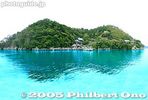
Verse 4 Lyrics (Chikubushima) 四番の英訳(竹生島)Azure blue flower garden, revered coral shrine.
Full of old-time stories, Chikubushima.
In the hands of Buddha, one young maiden lies.
She's sleeping in compassion, resting peacefully.
瑠璃の花園 珊瑚の宮
古い伝えの 竹生島
仏の御手に いだかれて
ねむれ乙女子 やすらけく
Ruri no hanazono, sango no miya
Furui tsutae no, Chikubujima
Hotoke no mite ni, idakarete
Nemure otomego, yasurakeku
Lake Biwa's most famous and sacred island is accessible by boat from Hikone, Nagahama, and Imazu. Color of the water in the photo is not real.
|
|
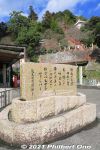
Verse 4 Song Monument, Chikubushima. Built in 1987 by Biwako Kisen, tour boat operator. 四番の歌碑。竹生島の桟橋のすぐそば。琵琶湖汽船が寄贈。The monument is right near the island's boat pier.
See more photos of Chikubushima here.
|
|

"Full of old-time stories, Chikubushima."The island has a complex of temples named Hogonji. It belongs to the Shingon Buddhist Sect (Buzan School). It is said that it was first built in 724. It is also the 30th temple in the 33 Temple Pilgrimage of Saigoku (Western Japan).
See more photos of Chikubushima here.
|
|
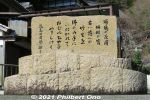
Verse 4 Song Monument, ChikubushimaAzure blue flower garden, revered coral shrine.
Full of old-time stories, Chikubushima.
In the hands of Buddha, one young maiden lies.
She's sleeping in compassion, resting peacefully.
Ruri no hanazono, sango no miya
Furui tsutae no, Chikubujima
Hotoke no mite ni, idakarete
Nemure otomego, yasurakeku
瑠璃の花園 珊瑚の宮
古い伝えの 竹生島
仏の御手に いだかれて
ねむれ乙女子 やすらけく
|
|

"Azure blue flower garden, revered coral shrine."
|
|
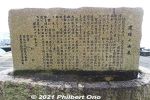
Rear of Verse 4 Song Monument, Chikubushima.It explains about the origin of the song. The monument was donated by the Biwako Kisen tour boat company which operates the boats going to the island as well as other tour boats in Lake Biwa, including the Michigan paddlewheel boat based in Otsu.
|
|

Broken dishes near the torii
|
|

"Full of old-time stories, Chikubushima." Karamon Gate, National Treasure
|
|

Chikubushima boat dock. The Verse 4 Song Monument on can be seen on the left.
|
|
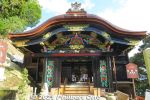
Karamon Gate, National Treasure. Renovated in March 2020.
|
|

Verse 3 Song Monument, Nagahama. Built and unveiled on June 25, 2017 by a non-profit citizens group in Nagahama formed to build this new song monument for the song's 100th anniversary. 三番の歌碑。長浜城のそば�The new Verse 3 Song Monument is near Nagahama Castle near the lake shore. It was unveiled with great fanfare by singer Kato Tokiko and others.
|
|
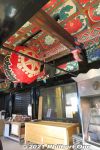
Kannon-do Hall, Hogonji Temple.
|
|

Buddha statue on Chikubushima
|
|
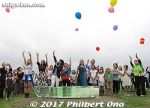
The song monument is made of glass and functions as a park bench for four people. Glassware is one of Nagahama's signature products. Verse 3 is engraved in the middle. It reportedly cost several million yen.After the unveiling, local singers sang the song with Kato Tokiko before everyone released balloons.
|
|
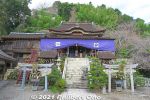
Tsukubusuma Shrine (National Treasure), Chikubushima 都久夫須麻神社
|
|

The first people to sit on the song monument. L-R: Nagahama-native Kitagawa Akihiro of the duo ~Lefa~, singer and special guest Kato Tokiko, Kada Yukiko former Shiga governor, and the mayor of Nagahama.
|
|
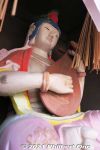
Benzaiten Goddess with her biwa lute.
|
|

On June 26, 2017, alumni of the Kyoto University Rowing Club rowed around Lake Biwa and took a break at Nagahama where they sang in front of the new song monument.
|
|

Benzaiten-do Hall, Hogonji Temple's Hondo main hall.
|
|

Verse 3 Song Monument at Nagahama's Hokoen Park. It is shaped like a boat and the top has a wavy surface like the water. It is called the "nami-makura" (rolling waves) design.The glass bench is positioned for sunset views over the lake.
Update: Unfortunately, this glass bench monument cracked and was replaced with another bench monument in Sept. 2021.
|
|
|

Verse 3 Song Monument in Nagahama's Hokoen Park near Nagahama Castle is engraved with Verse 3.浪のまにまに 漂えば
赤い泊火 懐かしみ
行方定めぬ 浪枕
今日は今津か 長浜か
Nami no mani mani, tadayoeba
Akai tomaribi, natsukashimi
Yukue sadamenu, nami makura
Kyo wa Imazu ka, Nagahama ka
|
|

The glass bench actually consists of several glass pieces. A few are largely transparent.
|
|

It's a beautiful design, but quite expensive. The non-profit group was unable to garner enough donations for the monument. They fell far short of the ¥10 million goal.
|
|
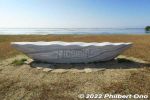
Verse 3 Song Monument at Nagahama's Hokoen Park. It is shaped like a boat and the top has a wavy surface like the water. It is called the "nami-makura" (rolling waves) design. Since the original glass bench song monument broke, it was replaced by this one made of stone having a similar shape and design concept.
|
|

Verse 3 Song Monument in Nagahama's Hokoen Park near Nagahama Castle is engraved with Verse 3.Nami no mani mani, tadayoeba
Akai tomaribi, natsukashimi
Yukue sadamenu, nami makura
Kyo wa Imazu ka, Nagahama ka
浪のまにまに 漂えば
赤い泊火 懐かしみ
行方定めぬ 浪枕
今日は今津か 長浜か
We drift from wave to wave, straying aimlessly.
On shore we see red fire, brings back memories.
With our sights set nowhere, rolling with the waves.
Today is Imazu or, Nagahama huh.
|
|
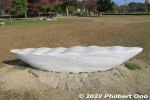
This side of the monument faces the lake. It's a popular bench to sit on during weekends and holidays.
|
|
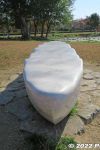
Wavy bench surface.
|
|

Memorial for the war dead
|
|

Amenomori is Takatsuki's showcase and flagship area. It's a quiet, rural part of town with waterwheels, roadside streams and flowers. Charming and picturesque.
|
|

This waterwheel has become one of the symbols of this area. It's in front of the Amenomori Hoshu-an museum.
|
|

Road in front of Amenomori Hoshu-an museum dedicated to Amenomori Hoshu (1668-1755), a Confucian scholar and leading diplomat to Korea during the Edo Period.
|
|

Front gate to Amenomori Hoshu-an museum built in 1984. Known as the East Asia Exchange House Amenomori Hoshu-an Museum. 東アジア交流ハウス雨森芳洲庵 MAP
|
|

Large zelkova (keyaki) tree at the museum. Takatsuki has numerous old and distinguished trees.
|
|

Amenomori Hoshu-an museum. Built on the land where Amenomori Hoshu's house once stood. Born in Amenomori, Amenomori Hoshu (1668-1755) was a Confucian scholar and leading diplomat to Korea during the Edo Period.
|
|

Entry to the Amenomori Hoshu-an. It exhibits things, books, documents, etc., related to Amenomori Hoshu. Admission 250 yen. Hours: 9 am - 4 pm, closed Mon. Phone: 0749-85-5095
|
|

This is the museum room with various exhibits related to Amenomori Hoshu and Japan-Korean relations during the Edo Period. Hoshu was based in Tsushima in Nagasaki, an island close to Korea.
|
|

Route of the Korea's royal embassy procession to Edo. The Korean kingdom sent an official mission to Edo when there was a significant occasion, such as the installation of a new shogun. They traveled along this route which also passed through Shiga.
|
|

At age 18, Hoshu went to Edo and studied Confucianism under Confucian scholar Kinoshita Jun'an. He was later employed by the Tsushima clan and was put in charge of Korean relations at age 22.
|
|

Statue of Hoshu. At age 25, Hoshu learned Chinese. At age 36, he lived and studied Korean in Pusan for 3 years during 1702-1705.
|
|

Statue of Amenomori Hoshu. He is regarded as a pioneer in Korean-Japanese relations and an internationally-minded person ahead of his time.
|
|

Hoshu rightly believed that language represented the culture, and learning the language was thus essential to understand the country.In 2017, Amenomori Hoshu's documents related to Japan-Korea relations during the Edo Period will be inscribed as a UNESCO Memory of the World.
|
|

Assembly hall. The museum sometimes holds events. Once a year, they conduct a homestay program for students from South Korea.
|
|

Faces of Hoshu on the wall.
|
|

Tea ceremony room.
|
|

Japanese garden at Amenomori Hoshu-an museum.
|
|
|

Amenomori Hoshu monument (not grave). Hoshu is buried in Tsushima, Nagasaki.
|
|
|
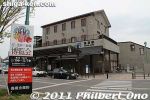
In 2011, the Go and Azai Sisters Expo is publicized everywhere in Nagahama. This is the east side of Nagahama Station.
|
|
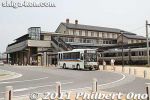
Go to the west side of Nagahama Station to catch the shuttle bus going to the Go and Azai Sisters Expo pavilions. Buy the roundtrip bus ticket at the little office near the bus stop at the train station.
|
|
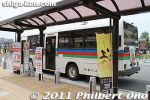
The 1,000 yen ticket includes admission to all three pavilions and roundtrip shuttle bus fare. Best to go the Odani pavilion first, then the Azai pavilion, and the central Nagahama pavilion on the way back.
|
|
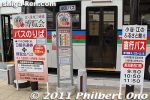
The shuttle bus leaves once or twice an hour. It comes with a bus guide.
|
|
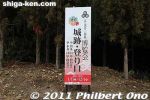
The Odani pavilion is at the foot of Odani Castle. Shuttle buses run between the three pavilions. Best to take a shuttle bus from Nagahama Station (West exit) and go directly to this pavilion.
|
|

Path to the Odani pavilion called Odani–Go no Furusato-kan (小谷・江のふるさと館).
|
|
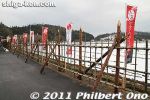
Fence modeled after a samurai battle fence.
|
|
|

Odani–Go no Furusato-kan (小谷・江のふるさと館) in Odani.
|
|
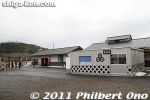
Rear view of Odani–Go no Furusato-kan (小谷・江のふるさと館) pavilion. The building in the foreground is a small gift shop.
|
|
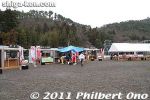
Outside the pavilion are food stalls and covered picnic tables.
|
|
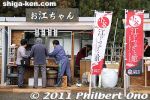
Food stall named "Ogo-chan."
|
|

Map of area surrounding the Odani pavilion.
|
|

Inside the Odani pavilion is this samurai costume which you can wear and take pictures of yourself.
|
|
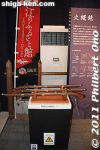
Also replica matchlock guns.
|
|
|
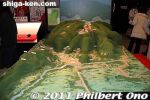
The Odani pavilion's most impressive exhibit was this scale model of Mt. Odani with Odani Castle in its heyday. On the left, you can also see Mt. Toragozen where Nobunaga's troops were perched to attack Odani Castle.
|
|
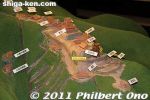
Model of Odani Castle. The mountain is quite steep and it was a difficult place to live logistically so normally, the castle lord and his family lived in the valley on the left side of the mountain.
|
|
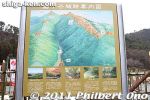
Map of Mt. Odani. From the Odani pavilion, there are shuttle buses going to Odani Castle. The roundtrip fare is 500 yen. It is a guided tour to the main parts of Odani Castle ruins. Photos here.
|
|

At the Odani pavilion at the foot of Mt. Odani, a shuttle bus to Odani Castle with a tour guide is provided for 500 yen roundtrip during 2011. A lot easier than walking up the mountain.
|
|
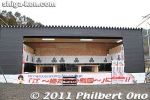
Outside the Odani pavilion is this outdoor stage. On weekends, a drama troupe performs.
|
|
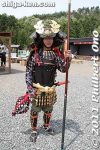
Samurai
|
|
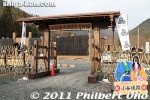
Entrance to Odani Castle Sengoku Historical Museum (小谷城戦国歴史資) opened in fall 2007. The museum is in the valley adjacent to Mt. Odani. Although the castle was atop the mountain, the castle lord and his family (Azai sisters) normally lived i
|
|
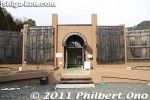
Odani Castle Sengoku Historical Museum. Admission 300 yen (not included in the expo ticket price). Can't take photos inside, but there are two small exhibition rooms explaining about the Azai clan and Odani Castle. No English.
|
|
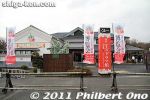
The third and main pavilion is in Azai. This is where the expo's opening ceremony was held on Jan. 15, 2011 with Shiga Governor Kada Yukiko and actor Tokito Saburo in attendance.
|
|
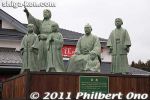
Statue of the Azai family in front of the Azai pavilion. As soon as they arrive here, most visitors take a picture of this sculpture.
|
|

About the Azai family sculpture. There's Nagamasa, Oichi, Chacha, Ohatsu Go, and Manpukumaru. They are gazing at Lake Biwa and Chikubushima from Odani.
|
|
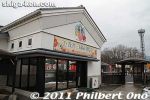
The Azai pavilion is called Azai–Go no Drama-kan (浅井・江のドラマ館). It displays kimono worn by the actresses (Ueno Juri, Miyazawa Rie) and samurai armor worn by the actors playing Oda Nobunaga and Azai Nagamasa. There’s also a small video
|
|

Food stalls
|
|
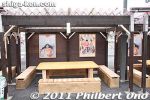
Table for food stalls.
|
|
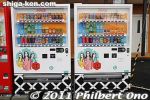
Vending machines with Azai sisters moif.
|
|
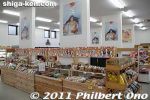
Inside the ift shop. This is the expo's largest gift shop. Buy your Azai sisters souvenirs and guide books here next to the Azai pavilion.
|
|
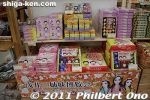
Gift shop
|
|

Go and Azai Sisters Expo banner.
|
|
| 2772 files on 11 page(s) |
1 |
 |
 |
 |
 |
|